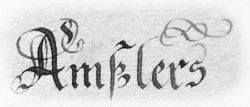how the mill from Bözen found its way to Aarau
The above book will be published at the end of May. The blurb mainly refers to the mill in Bözen and the castle mill in Aarau. But there is a lot more to this book. It also contains information about the families of the mill owners and local history. These are the tree main points:
- The Aarau Castle Mill and the Bözen Mill
- Grain farming in the upper Fricktal
- Family histories of the millers of Bözen
The Aarau Castle Mill and the Bözen Mill
The first third of the book deals with the history of the two mills in Aarau and Bözen. The castle mill in Aarau was inaugurated almost 50 years ago, whereas the much older mill in Bözen was already mentioned in the Habsburg chronicles around 1305.

The Aarau Castle Mill was originally conceived as an open-air museum. Following a comprehensive renovation in 2019/2020, the castle mill is now experiencing a new heyday.
It is a contemporary witness to the historic miller’s trade and now also serves as a commercial space. The Chalira company operates a spice, mustard and grain mill in the mill building. Its centerpiece is the historical milling machinery from Bözen. Parts of the grinder pedestal with centuries-old oak beams and the four base stones have also been preserved.
The grain mill in Bözen probably existed before the 13th century, as it was part of the Elfingen estate, owned by the Murbach monastery in Alsace. The Murbach monastery was founded in the 8th century and the Benedictine monks owned widely scattered property in what is now Switzerland. A series of sixteen extensive farms stretched from the area around Basel across the Aargau Jura and up the Reuss valley to Lucerne.

Today, only the residential building at the front left still stands, the core of which dates back to the 16th century. It also housed the mill. An archaeological investigation of this ancient building revealed surprising secrets.
The large barn on the right and the two granaries in the background were demolished around 1970 in connection with the construction of the highway. The grinder and mill wheel were also removed at this time. Like a heart transplant these facilities of the historic grain mill were moved to the new open-air museum in Aarau.
The connection between the two disparate mills was the impetus for this work.
Grain farming in the upper Fricktal
An extensive chapter is devoted to the history of grain cultivation in the upper Fricktal. This area was already inhabited in the Bronze Age. Bözen was located on the strategically important road over the Bözberg pass, which connected the Roman city Augusta Raurica with the legionary camp in Vindonissa.
For the Romans and later the Alemanni, grain was a decisive factor in their diet. More precise figures on crop yields are recorded from the 16th century onwards with the Bernese rule and its efficient administration. The levies known as “tithes” could only be redeemed in the 19th century by monetary payment. I have examined this lengthy process and interpreted it from today’s perspective.

Most people were self-sufficient at that time. The question arises whether and how poor harvests affected people’s life expectancy. The theoretical harvest yields could be calculated based on the tithes paid. The annual mortality rate was determined from the church registers and these figures were compared with each other.
Various sources indicate a strong population growth between 1653 and 1850. This led to increasing poverty and the overdue improvements in agricultural production progressed very slowly. In the middle of the 19th century, the municipal authorities in Bözen sought ways and means to relieve themselves of the burden of caring for the poor. I describe the social conditions of the time and how the journey to America was financed for families who were willing to emigrate.
Family histories of the millers of Bözen
The last third of the book is devoted to the owners of the Bözen mill. This should be an interesting chapter for family researchers. Persons for whom further information is available, are highlighted in italics:
| Othmar Heuberger (mentioned 1536) |
| Caspar Heuberger (mentioned 1562) |
| Sebastian Heuberger (mentioned 1614) |
| Hans Heuberger I (1590-164x) lower bailiff from 1630 until 1641) |
| Hans Heuberger II (1619-1667) died of the pest and was followed by fief miller Heinrich Heuberger |
| Abraham Heuberger (1657-1724) |
| Conrad Heuberger buys the mill 1698 from above Abraham |
| Caspar Hirzel buys the mill 1701 |
| Hans Jakob Heuberger and Hans Conrad Gebhard, both living in the Palatinate, buy the mill 1705 |
| Baschi Amsler buys half the mill 1731 from Jakob Heuberger in the Palatinate |
| Heinrich Heuberger from Elfingen and Linn buys 1731 Amsler’s share of the mill |
| Caspar Brack buys 1736 half the mill from Heinrich Heuberger |
| Johannes Heuberger from Elfingen buys 1772 Brack’s share of the mill |
| fief miller Jakob Heuberger I (1766-1845) buys 1797 half of the mill |
| above Jakob Heuberger I buys 1800 the second half of the mill from the owners in the Palatinate and sells it in two steps 1815 and 1826 to his son Jakob II (1790-1867) |
| through inheritance the mill goes 1848 to Jakob Heuberger III (1821-1903) |
| daughter Louise Landbeck-Heuberger inherits the mill, her son Friedrich is miller |
| Adolf Baumann from Bottenwil buys the mill 1920 from the Landbeck heirs |
| The building department of canton Aargau buys the mill 1972 from the Baumann heirs |
| 1997 the mill is acquired by the municipality of Bözen |
An unbroken succession of mill owners can be observed from the 16th century onwards. For centuries, members of the Heuberger family repeatedly owned the Bözen mill. It seems as if the mill simply passed from one generation to the next. But my research shows a different picture.
For several decades, the mill was even in “foreign hands”, the owners were based in Kraichgau in the Palatinate. There were many ownership changes in the 18th century. Among the owners of the mill were Caspar Hirzel, Heinrich Heuberger from Linn, Sebastian Amsler and two generations of the Brack family from Bözen and two generations of the Heuberger family from Elfingen.
The branches of the Heuberger family are documented in detailed genealogical charts. The Brack and Baumann miller families are also described. It is remarkable that descendants of these families still live in Böztal today.

right side: Family tree of the first Heuberger mill owners
The plinth stones of the mill table are among the oldest components from Bözen. One of the four limestone pillars has the year 1575 carved into it. The Heuberger coat of arms can be seen between the numbers 15 and 75, with the initials BH above it. This probably refers to the miller Sebastian Heuberger, who is referred to in historical sources as “Baschen” or “Baschion”. Baschi Heuberger, who died in 1617, is the progenitor of the first mill owners and founder of the “Sebastian line” of the Heuberger family.
In the Aargau State archives I consulted the official accounts of the Bernese bailiwick of Schenkenberg, the Effingen court records from 1667 to 1798, judicial manuals and the fire insurance registers from 1809 to 1899.
In addition, there were tax rolls, sales deeds, minutes of municipal meetings and records of the tithes in the Bözen municipal archives. Purchase contracts, inheritance records, guardianship accounts, parent estate insurances, etc. provided valuable information.
I have augmented genealogical data from the church records in order to sketch as varied a picture as possible of the circumstances of the respective mill owners. I also used the choir court manuals and house visitation records from the Bözen parish archives.
These additional sources, which are listed in the appendix, revealed interesting episodes. For example, the choir court manual tells of Abraham the scoundrel and the dismissal of a sub-bailiff, drinking bouts, brawls and adultery. Dragoons, parish priests and stagecoach operators have their say in the documents.
Conclusion
Writing this book was an exciting journey through the history of the village where I spent my childhood and youth. There was new territory to discover and supposedly familiar things to be seen with different eyes. The journey took around four years, sometimes it progressed quickly, other times there were relaxing breaks. Thanks to loyal companions who accompanied me on my adventurous trip, I was never alone. Some were by my side from time to time or just for a short while, others from the very beginning. They all helped me to carry my backpack when it felt too heavy, or they relieved me of unnecessary ballast. I am grateful to them.

Ordering the new book
order online: “Two mills – one story”




